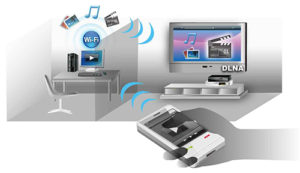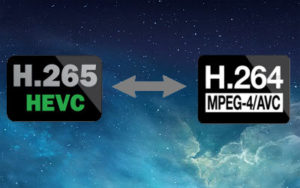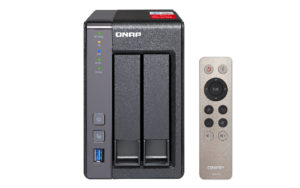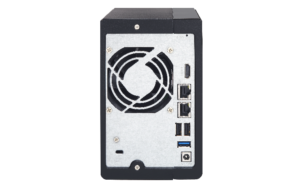Transcoding 4K Media on the QNAP TS-251+ NAS Server?

Transcoding on a NAS such as the QNAP TS-251+ device is the ability for a multimedia file to be changed from it’s existing format or codec to one that is better suited to the destination device. In this file access, the QNAP TS-251+ NAS is the host device and the device you want to play the file is the client. Transcoding is typically required when a media file is more recently released than the client device that is accessing it, so the newer compression or playback format is unknown to the device you want to access it with.Alternatively, you want to access the movie or music on your QNAP TS-251+ and do not want to use the original file in its full size. Transcoding can enable you to stream a much smaller version in weight or resolution if needed.
Which client devices require transcoding from the QNAP TS-251+ NAS
Destination devices range greatly and are often referred to as the client device. Common client devices that your QNAP TS-251+ device will be accessed by are often:

- iPad or Android Tablet
- iPhone or Android Smartphone
- Smart TV or DLNA supported monitor
- Macbook, Laptop or Netbook device
- Sound systems such as Bose, Sonos and Sony DLNA systems
- Home Theatre Systems
- Network and internet-enabled gaming consoles such as PS4, Xbox One and Nvidia Shield
Transcoding between a QNAP TS-251+ and your media can be of tremendous benefit for those with limited internet bandwidth, download limits or low powered devices.
What are the Specifications of the QNAP TS-251+ NAS?
The specifications for the QNAP TS-251+ NAS are below and like all NAS devices, the CPU and Memory play a big part in how well it performs at transcoding. The key factors to consider are if the device features an x86 or ARM-based CPU, does the QNAP TS-251+ CPU feature a transcoding engine and how much RAM the device arrives with for multiple transcoding tasks. Below are the QNAP TS-251+ specs:
What is the difference between H.264 and H.265 4K Media on a NAS

H.264 and H.265 are common codecs of modern digital media. H264 is also referred to as AVC by experts (Advanced Video Coding) and is considered the standard for video file compression. This allows for media originally created for large-scale entertainment to be recording, compressed, and distributed to the home and smaller scale production of digital video content watched by you, the consumer.
H265 is the newer and more consumer-friendly alternative to H264. It is also known as HEVC (High-Efficiency Video Coding) and was developed in order resolve issues of enormous 4K media files being just too large for your client device to playback. H.265 has become so popular and data saving that chances are that the YouTube clip, iTunes media or iPlayer content you watched was in .265 and HEVC. Typically a modern NAS such as the QNAP TS-251+ will playback with JUST H.265 or it will PLayback both H.264 and H.265. The latter pretty much being exclusive to x86 or AMD based NAS CPU devices.
The QNAP TS-251+ NAS 4K H.265 8-bit 30fps 46Mb/s Test 1- How well does it perform?
We pushed the QNAP TS-251+ NAS to transcode a 4K H265 media file. It was an 8-bit recording, running at 30 frames per second and featured a bitrate of 46 megabits per second. The QNAP TS-251+ playback results were:
The QNAP TS-251+ NAS 4K H.265 8-bit 25fps 38Mb/s Test 2 – How well does it perform?
Next, we pushed the QNAP TS-251+ NAS to transcode a 4K H265 media file. It was an 8-bit recording, but this time running at 25 frames per second and featured a bitrate of just 38 megabits per second. The QNAP TS-251+ playback results were:
The QNAP TS-251+ NAS 4K H.264 8-bit 30fps 51Mb/s Test 3 – How well does it perform?
Next, we pushed the QNAP TS-251+ NAS to transcode a 4K H264 this time, the media file was an 8-bit recording, but this time back at 30 frames per second and featured a bitrate of 51 megabits per second, our highest yet. The QNAP TS-251+ playback results were:
The QNAP TS-251+ NAS 4K H.265 10-bit 25fps 19Mb/s Test 6 – How well does it perform?
Now we started transcoding with the newer and more efficient H.265 4K format on the QNAP TS-251+. Using a similar file, but encoded in H265, the media file was a 10-bit recording, 25 frames per second but this time with a much lower bitrate of just 19 megabits per second. The QNAP TS-251+ playback results were:
The QNAP TS-251+ NAS 4K H.265 10-bit 30fps 38Mb/s Test 7 – How well does it perform?
We then ran a much denser H.265 4K file on the QNAP TS-251+. This H265 file was another 10-bit recording, at 30fps but this time with a much higher bitrate of 38 megabits per second. The QNAP TS-251+ playback results were:
The QNAP TS-251+ NAS 4K H.265 10-bit 42fps 38Mb/s Test 8 – How well does it perform?
Test number 8 was an almost identical file to that of test 7, but this H.265 4K file on the QNAP TS-251+ featured a much higher frames per second count of 42fps. To confirm, this test was a 10-bit, 42fps h265 file at 42 frames per second. The QNAP TS-251+ playback results were:
The QNAP TS-251+ NAS 4K H.265 10-bit 50fps 23Mb/s Test 9 – How well does it perform?
Moving it higher and higher, test 9 featured an even more punishing H.265 4K file on the QNAP TS-251+. It featured the highest frames per second count yet at 50fps. To confirm, this test was a 10-bit, 50fps h265 file at 42 frames per second. The QNAP TS-251+ playback results were:
The QNAP TS-251+ NAS 720p H.265 8-bit 24fps 1Mb Test 11 – How well does it perform?
In an effort to fully test the spectrum of the QNAP TS-251+ NAS and it’s transcoding, we wanted to also test HD Playback (to give the 4K results a sense of perspective). First up was 720p. This 720 HD file was another efficient H.265 8-bit file. It ran at 24fps and was just 1Mb in bitrate. The QNAP TS-251+ NAS performed as expected (given the earlier results):
The QNAP TS-251+ NAS 1080p AVC 8-bit 30fps 0.8Mb Test 12 – How well does it perform?
Next up we gave 1080p transcoding a try on the QNAP TS-251+ NAS. This AVC file (so H264 again) an 8-bit file running at a fluid 30fps. However, with a lower bitrate of just 0.8Mb, it should not have pushed the QNAP TS-251+ as much as earlier tests. The results for 1080 HD transcoding were:
The QNAP TS-251+ NAS 1080p H.265 8-bit 24fps 405kb/s Test 10 – How well does it perform?
In an effort to maintain fairness, we also covered an H.265 1080p file, so a comparison between this and Test 12 could be made. Ignore the test numerical order numbers, as this needed to be re-done (blame the QNAP TS-251+ needing a firmware update mid transcode and therefore spoiled the results the first time). This was an HEVC/H265 8-bit file running at 24fps, but with a comparatively low bitrate of just 405kbps. The results (correct this time) were again, fairly expected:
The QNAP TS-251+ NAS Ultra HD 4K H.264 8-bit 24fps 22Mb/s Test 15 – How well does it perform?
Finally, we decided to end on an older and currently more common owned 4K type of media file. This was kind of our control tests for most NAS and was no exception for the QNAP TS-251+. This UHD file in 4K was an 8-Bit file, arriving in 24 frames per second and at a bitrate of 22megabits per second. For those who have owned 4k media for a while and want to consider their older H264 material, this test would be of interest. The results were.
I hope these 4K results were of use to you and this helps you consider which NAS you wish to you buy in 2018, whether it is the QNAP TS-251+ or something more or less suited to your needs.
📧 SUBSCRIBE TO OUR NEWSLETTER 🔔🔒 Join Inner Circle
Get an alert every time something gets added to this specific article!
This description contains links to Amazon. These links will take you to some of the products mentioned in today's content. As an Amazon Associate, I earn from qualifying purchases. Visit the NASCompares Deal Finder to find the best place to buy this device in your region, based on Service, Support and Reputation - Just Search for your NAS Drive in the Box Below
Need Advice on Data Storage from an Expert?
Finally, for free advice about your setup, just leave a message in the comments below here at NASCompares.com and we will get back to you. Need Help?
Where possible (and where appropriate) please provide as much information about your requirements, as then I can arrange the best answer and solution to your needs. Do not worry about your e-mail address being required, it will NOT be used in a mailing list and will NOT be used in any way other than to respond to your enquiry.
Need Help?
Where possible (and where appropriate) please provide as much information about your requirements, as then I can arrange the best answer and solution to your needs. Do not worry about your e-mail address being required, it will NOT be used in a mailing list and will NOT be used in any way other than to respond to your enquiry.

|
 |
The Best Bits (and Worst Bits) of NAS of 2025!
Minisforum MS-02 Ultra Review
Minisforum N5 NAS, 6 Months Later - Better, Worse, the Same?
Beelink ME Pro NAS Revealed
Best SOLID STORAGE NAS of 2025
Should You Worry About the NanoKVM Hidden Microphone?
Access content via Patreon or KO-FI
Discover more from NAS Compares
Subscribe to get the latest posts sent to your email.




















Thanks for posting low resolution unreadable images for the comparison while also making zero comments regarding whether any of these tests resulted in working transcoding without lag or frame drops. Useless article from a useless website